19 Apr CRYPTOCORYNE technical description and management (all varieties)
Name: Cryptocoryne
Family: Araceae
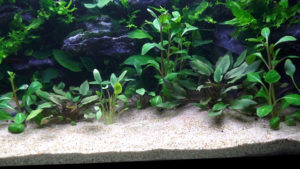
Origin and Habitat: Cryptocoryne comes from Southeast Asia, Sri Lanka and the New Guinea. They are made of many rhizomes from which start the leaves, there are many varieties, each with its different morphology, however, talking about this aspect, the most important feature is the ability to adapt, is an aquatic varieties resistant to all types of waters, alkaline and acid. In the aquarium, it can happen that the crypto lose all the leaves, and then regenerate from rhizomes in a totally different color. They change their appearance depending on the condition, for example, with so much light are darken and grow bushier and low, with no much light instead get longer and brighter. Cryptocoryne is a slow-growing variety and being from Araceae family like Anubias, are very similar but the main difference is that the cryptocoryne are not epiphytes, so you cant positioned on driftwood or rocks, they need for this reason a substrate. We usually use this plant in the middle of the tank, but in some case and some variety you can planting on the front of aquarium.
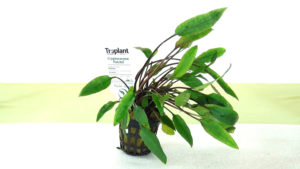 CRYPTOCORYNE PETCHII: Cryptocoryne that can exceed 15 cm high with spear-shaped leaves, if kept in good light and nutrients develops a very pronounced red.
CRYPTOCORYNE PETCHII: Cryptocoryne that can exceed 15 cm high with spear-shaped leaves, if kept in good light and nutrients develops a very pronounced red.
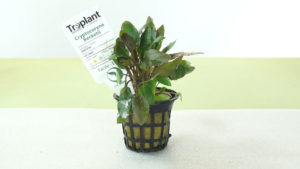 CRYPTOCORYNE BECKETII: Very similar to Petchii but in reduced form, about half, if kept well with a good light and nutrients becomes dark red almost reddish brown, even the leaf is reduced, not only the height.
CRYPTOCORYNE BECKETII: Very similar to Petchii but in reduced form, about half, if kept well with a good light and nutrients becomes dark red almost reddish brown, even the leaf is reduced, not only the height.
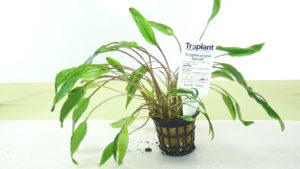 CRYPTOCORYNE NEVILLI: Initially on the green, very high, can easily reach 15 cm, has a little narrow and elongated leaf with a rounded tip, it can also take on a more dark color on the leaves.
CRYPTOCORYNE NEVILLI: Initially on the green, very high, can easily reach 15 cm, has a little narrow and elongated leaf with a rounded tip, it can also take on a more dark color on the leaves.
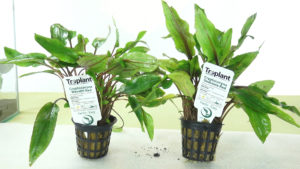 CRYPTOCORYNE WENDTII RED and UNDULATA RED: Are very similar in a submerged form, Undulata red becomes more reddish while the first develops a dark red more accentuated on the stems, both varieties are high and develop wavy leaves in the leaf edges. Only when you buy you can see the difference; the leaf of red Wenditii has the tip more rounded, while the undulata has the pointed leaf.
CRYPTOCORYNE WENDTII RED and UNDULATA RED: Are very similar in a submerged form, Undulata red becomes more reddish while the first develops a dark red more accentuated on the stems, both varieties are high and develop wavy leaves in the leaf edges. Only when you buy you can see the difference; the leaf of red Wenditii has the tip more rounded, while the undulata has the pointed leaf.
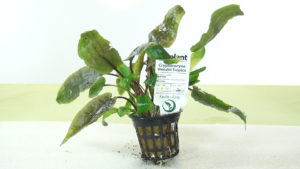 CRYPTOCORYNE WENDTII TROPICA: This kind of Cryptocoryne has reduced size, not more than 10 cm, brown, broad-leaved and bolted.
CRYPTOCORYNE WENDTII TROPICA: This kind of Cryptocoryne has reduced size, not more than 10 cm, brown, broad-leaved and bolted.
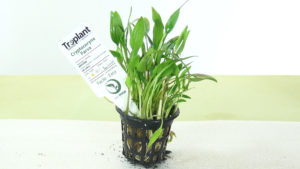 CRYPTOCORYNE PARVA: Rounded and with a small leaf shaped like spades, the leaf remains green and small, and is one of the varieties that stays green. Grow about 10 cm tall but with much more light remains low.
CRYPTOCORYNE PARVA: Rounded and with a small leaf shaped like spades, the leaf remains green and small, and is one of the varieties that stays green. Grow about 10 cm tall but with much more light remains low.
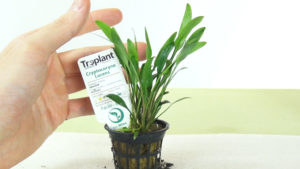 CRYPTOCORYNE LUCENS: Identical to Parva, but with more narrow elongated leaf and rounded tip, sometimes in the aquarium can take more dark or sometimes stays green, it becomes higher then parva.
CRYPTOCORYNE LUCENS: Identical to Parva, but with more narrow elongated leaf and rounded tip, sometimes in the aquarium can take more dark or sometimes stays green, it becomes higher then parva.
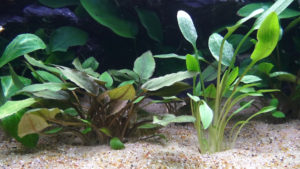
Reproduction and moltipication: Remember that the rhizomes, to find nutrients moving under the sand, sometimes even along the whole tank and then leak out and give birth to a new plant, the same applies to the roots, with inert bottom develop more. At the time of planting it can be divided into 2 or 3 parts depending on the size.
Fertilizer and substrate: It is advisable to use gravelit, clay or porous stone as the first layer on the bottom, for better oxygenation and water flow, then a mineral rich and fertile substrate, we recommend fertilized sand but also inert okay. It can grow in the absence of CO2, but with proper emission of co2 and a strong light, the variety will grow faster, producing visible oxygen from leaves, the so-called pearling.
Price for jar about 6/7 €.
Ideal temperature range: 22°- 28° Celsius
Light demand: medium
Growth speed: medium / slow
PH range: 6 – 7.5
GH range: 7-12
Cultivation difficuly: easy
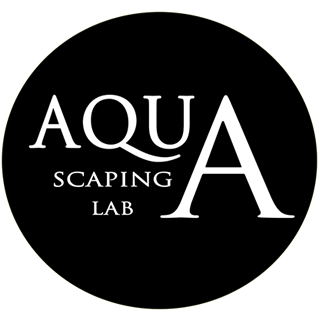


 English
English Italiano
Italiano